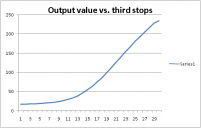
-
Another member asked me to upload .MTS files and identify which frames from the file I used in the above post. I deleted all of the source files from those tests, so I recreated the test and uploaded to YouTube. I tried to upload even a short .MTS clip, and it was way over the 8MB attachment limit.
-
@mvarnado flat surface with soft corner lenses are going to dramatically increase the banding especially when it's under or over-exposed since it'll showcase a very uniform gradient that the AVCHD codec is going to intensively compress to save memory (and it's not due to 8 bit 4:2:0 since 8 bit is the color depth and there are plenty of colors values between two strips and 4:2:0 is just a sampling for each independent pixel resulting in a more "blur" kind of effects on the edges but since there are no edges when a pixel actually has to choose between two different colors. It's so unnoticeable on a flat surface).
-
Certain hacks may change the behavior for this type of banding. I think horizontal banding is a worse issue than this gradient banding. But with horizontal banding you can at least remove the banding source in most scenes by changing light sources or angles. So whatever.
-
@ Gk I think you may need to research a bit more on 8 bit banding. Your understanding seems incorrect.
-
@caveport I think he made sense except he contradicted by first saying it's a flat surface issue and then saying it's unnoticeable on a flat surface, which was probably just be typo. I agree with him though that it's probably AVC issue. When taking still photos there is no gradient banding issue that I'm aware of, which would mean the sensor is okay it's just codec issue when doing video.
-
@mvarnado, I'm seeing the same banding in the MTS as in your YouTube upload. So the banding is coming from the GH2, not from your workflow.
I see two kinds of bands. There is regular 8-bit banding in the smooth gradient off to the right. This tiny bit of banding is barely noticeable, if you ask me. You can't really avoid it, but it is minimized by exposing in the middle (and applying exposure compensation in post, if necessary). Banding is worst in the shadows, and also a bit worse in the highlights just before clipping.
Attached is a plot of the GH2's luma response profile. You can see that there is a decreasing number of code values per stop above 220 and below 75.
Then there's a wide blue band and a wide green band just before the image is clipped to white. I've never seen that before. It seems to be a quirk of the GH2 near the clipping level. I suppose you'd avoid it by just keeping your gradients away from the clipping level. Or perhaps it is related to the ISO setting. ISO 1250 is generally better than ISO 1000, if you pick 1600 first and then switch to 1250 (avoiding the ISO noise bug).
The thing about banding is that if you look for it, you will find it. Stop looking for it and you'll be much happier. Just concentrate on the images, not the pixels and the levels.

 Panasonic_GH2_luma_profile.png528 x 336 - 6K
Panasonic_GH2_luma_profile.png528 x 336 - 6K -
This is the part that is wrong: "it's not due to 8 bit 4:2:0 since 8 bit is the color depth and there are plenty of colors values between two strips and 4:2:0 is just a sampling for each independent pixel..."
-
-
I'm very appreciative of @balazer for taking the time to look into this. I'm learning a lot from all of the ongoing discussion as well. I agree that gradient banding can be a relatively minor issue so long as story and overall cinematography is creative and on point. I am in my infancy in terms of learning the more technical aspects. I'll probably look into the zone system and experiment with exposure.
Howdy, Stranger!
It looks like you're new here. If you want to get involved, click one of these buttons!
Categories
- Topics List23,964
- Blog5,723
- General and News1,342
- Hacks and Patches1,151
- ↳ Top Settings33
- ↳ Beginners254
- ↳ Archives402
- ↳ Hacks News and Development56
- Cameras2,361
- ↳ Panasonic990
- ↳ Canon118
- ↳ Sony154
- ↳ Nikon96
- ↳ Pentax and Samsung70
- ↳ Olympus and Fujifilm99
- ↳ Compacts and Camcorders299
- ↳ Smartphones for video97
- ↳ Pro Video Cameras191
- ↳ BlackMagic and other raw cameras121
- Skill1,961
- ↳ Business and distribution66
- ↳ Preparation, scripts and legal38
- ↳ Art149
- ↳ Import, Convert, Exporting291
- ↳ Editors191
- ↳ Effects and stunts115
- ↳ Color grading197
- ↳ Sound and Music280
- ↳ Lighting96
- ↳ Software and storage tips267
- Gear5,414
- ↳ Filters, Adapters, Matte boxes344
- ↳ Lenses1,579
- ↳ Follow focus and gears93
- ↳ Sound498
- ↳ Lighting gear314
- ↳ Camera movement230
- ↳ Gimbals and copters302
- ↳ Rigs and related stuff272
- ↳ Power solutions83
- ↳ Monitors and viewfinders339
- ↳ Tripods and fluid heads139
- ↳ Storage286
- ↳ Computers and studio gear560
- ↳ VR and 3D248
- Showcase1,859
- Marketplace2,834
- Offtopic1,319



